Bhadeshia H.K.D.H. Bainite In Steels. Transformations, Microstructure and Properties
Подождите немного. Документ загружается.

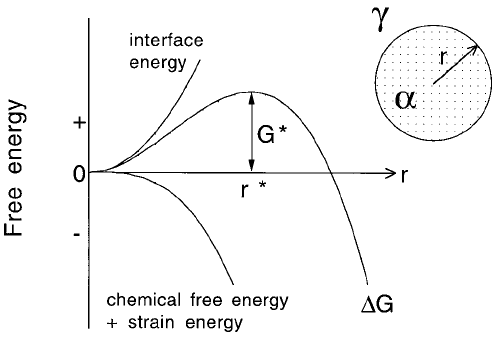
tions are glissile so the mechanism does not require diffusion. The only barrier
is the resistance to the glide of the dislocations. The nucleation event cannot
occur until the undercooling is suf®cient to support the faulting and strains
associated with the dissociation process that leads to the creation of the new
crystal structure (Fig. 6.8).
The free energy per unit area of fault plane is:
G
F
n
P
A
G
CHEM
G
STRAIN
2
fn
P
g6:7
where n
P
is the number of close-packed planes participating in the faulting
process,
A
is the spacing of the close-packed planes on which the faulting is
assumed to occur. The fault energy can become negative when the austenite
becomes metastable.
For a fault bounded by an array of n
P
dislocations each with a Burger's
vector of magnitude b, the force required to move a unit length of dislocation
array is n
P
o
b.
o
is the shear resistance of the lattice to the motion of the
dislocations. G
F
provides the opposing stress via the chemical free energy
change G
CHEM
; the physical origin of this stress is the fault energy which
becomes negative so that the partial dislocations bounding the fault are
repelled. The defect becomes unstable, i.e. nucleation occurs, when
G
F
n
P
o
b 6:8
Take the energy barrier between adjacent equilibrium positions of a disloca-
tion to be G
o
. An applied shear stress has the effect of reducing the height of
this barrier (Conrad, 1964; Dorn, 1968):
Kinetics
137
Fig. 6.7 The activation energy barrier G
and the critical nucleus size r
according
to classical nucleation theory based on heterophase ¯uctuations.
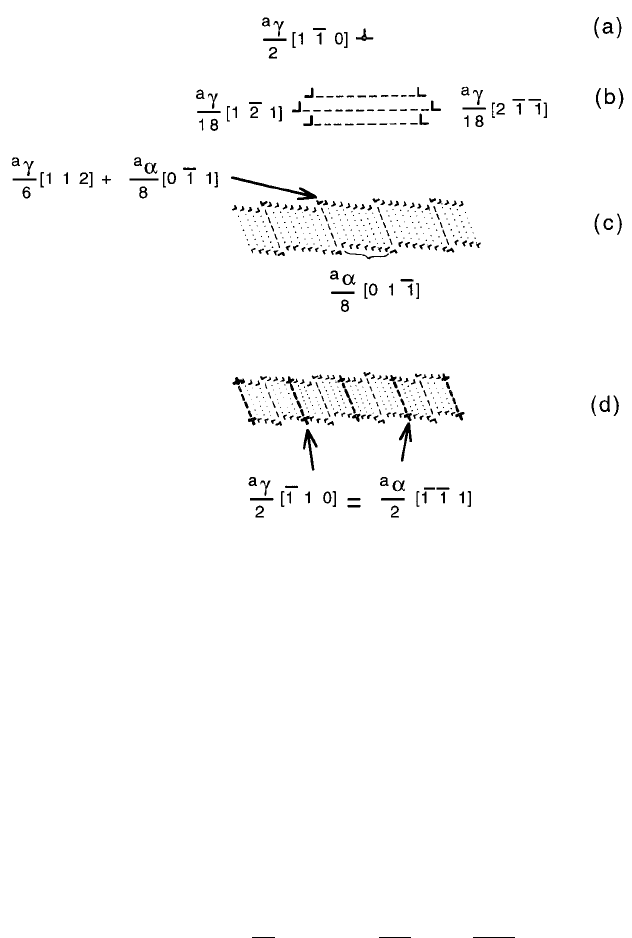
G
G
o
v
6:9
where v
is an activation volume and
is the temperature independent
resistance to dislocation motion (Fig. 6.9). In the context of nucleation, the
stress is not externally applied but comes from the chemical driving force.
On combining the last three equations we obtain
G
G
o
A
b
G
STRAIN
2
n
P
b
v
A
v
b
G
CHEM
6:10
It follows that with this model of nucleation the activation energy G
will
decrease linearly as the magnitude of the driving force G
CHEM
increases.
This direct proportionality contrasts with the inverse square relationship of
classical theory.
Bainite in Steels
138
Fig. 6.8 Olson and Cohen model for the nucleation of martensite. (a) Perfect
screw dislocation in austenite. (b) Three-dimensional dissociation over a set of
three close-packed planes. The faulted structure is not yet that of . (c) Relaxation
of fault to a body-centred cubic structure with the introduction of partial disloca-
tions in the interface. (d) Addition of perfect screw dislocations which cancel the
long range strain ®eld of the partials introduced in (c).
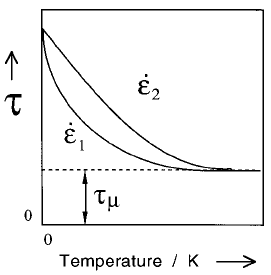
6.3 Bainite Nucleation
The linear relationship between G
N
and T
h
(Fig. 6.4) can be used to deduce
whether nucleation involves dislocation dissociation or heterophase ¯uctua-
tions (Bhadeshia, 1981a). The nucleation rate I
V
will have a temperature depen-
dence due to the activation energy:
I
V
/ expfG
=RTg6:11
where is an attempt frequency. It follows that
G
/ T where R lnfI
V
=g6:12
We now assume that there is a speci®c nucleation rate at T
h
, irrespective of the
type of steel, in which case is a constant, negative in value since the attempt
frequency should be larger than the actual rate. This gives the interesting result
that
G
N
/ T 6:13
which is precisely the relationship observed experimentally. This is evidence
for nucleation by the dissociation of dislocations with the activation energy
proportional to the driving force, as opposed to the inverse square relationship
predicted by classical theory. The activation energy G
in this model comes
from the resistance of the lattice to the motion of dislocations.
Nucleation corresponds to a point where the slow, thermally activated
migration of glissile partial dislocations gives way to rapid, breakaway
dissociation. This is why it is possible to observe two sets of transformation
units, the ®rst consisting of very ®ne embryo platelets below the size of the
operational nucleus, and the second the size corresponding to the rapid growth
Kinetics
139
Fig. 6.9 Temperature dependence of the applied stress necessary to move a dis-
location at two different strain rates (
_
2
>
_
1
.
is the athermal resistance which
never vanishes. After Conrad (1964).
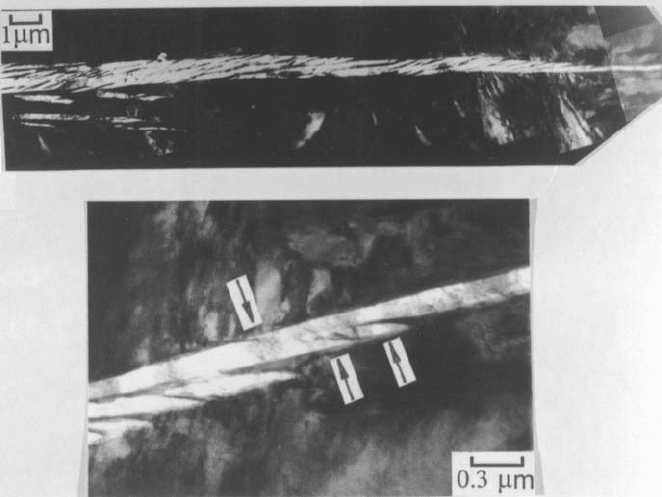
to the ®nal size. Intermediate sizes are rarely observed because the time period
for the second stage is expected to be much smaller than that for the ®rst.
Figure 6.10 shows that in addition to the fully growth sub-units (a few micro-
meters in length), there is another population of much smaller (submicron)
particles which represent the embryos at a point in their evolution prior to
breakaway dissociation.
6.4 Empirical Equation for the Bainite-Start Temperature
Steven and Haynes (1956) measured the bainite-start temperature by
isothermally transforming a large number of engineering steels with chemical
composition in the range (wt%):
Carbon 0.1±0.55 Nickel 0.0±5.0
Silicon 0.1±0.35 Chromium 0.0±3.5
Manganese 0.2±1.7 Molybdenum 0.0±1.0
Bainite in Steels
140
Fig. 6.10 Transmission electron micrograph of a sheaf of bainite in a partially
transformed sample. A region near the tip of the sheaf in (a) is enlarged in (b).
The arrows in (b) indicate possible sub-operational embryos which are much
smaller than the fully grown sub-units seen in (a). After Olson et al. (1989).

and expressed their results empirically as:
B
S
8C 830 270w
C
90w
Mn
37w
Ni
70w
Cr
83w
Mo
6:14
where w
i
is the wt% of element i in solid solution in austenite.
6.5 The Nucleation Rate
The linear dependence of the activation energy for nucleation on the driving
force can be substituted into a nucleation rate equation to obtain:
y
I
V
C
3
exp
G
RT
C
3
exp
C
4
C
5
G
m
RT
6:15
where G
m
is the maximum value of G
CHEM
(Fig. 6.2c) and C
i
are positive
constants. The nucleation rate at T
h
is obtained by setting G
m
G
N
I
T
h
C
3
exp
C
4
C
5
G
N
RT
h
6:16
It follows that
I
V
I
T
h
exp
C
4
T
RTT
h
C
5
R
G
m
T
G
N
T
h
6:17
with T T
h
T. Recall that the G
N
function was justi®ed with martensite
nucleation theory assuming that the nucleation rate I
T
h
is the same for all steels
at T
h
. For two different steels A and B,
I
T
A
h
I
T
B
h
exp
C
4
C
2
C
5
T
A
h
T
B
h
RT
A
h
T
B
h
6:18
Since I
T
A
h
I
T
B
h
it follows that C
4
C
2
C
5
so that
I
V
C
3
exp
C
4
RT
C
4
G
m
C
2
RT
6:19
In this equation the constant C
2
is known since it comes from the slope of the
G
N
function (equation 6.1) so the two unknowns are C
3
and C
4
which are
obtained by ®tting to experimental data. The pre-exponential factor C
3
is the
product of a number density of nucleation sites (N
0
V
) and an attempt frequency
().
Kinetics
141
y
Bhadeshia (1982b); Rees & Bhadeshia (1992); Chester & Bhadeshia (1997); Singh (1998).
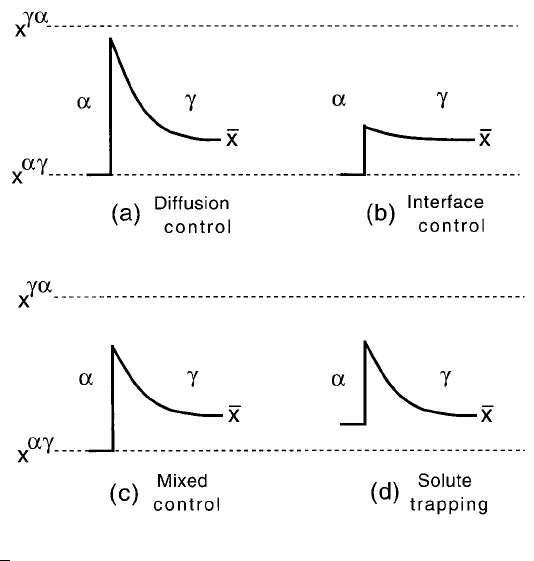
6.6 Growth Rate
The displacement of an interface requires the atoms of the parent to transfer
into and adopt the crystal structure of the product phase. The ease with which
this happens determines the interface mobility. There may also be a partition-
ing of solutes in which case diffusion may limit the movement of the interface.
The two processes of diffusion and mobility are in series; the velocity as cal-
culated from the interface mobility must therefore match that due to the diffu-
sion of solute ahead of the interface. Both processes dissipate the available free
energy, so motion is always under mixed control. However, a process is said to
be diffusion-controlled when most of the free energy is dissipated in the diffu-
sion of solute. Interface-controlled growth occurs when the larger proportion
of the free energy is consumed in the transfer of atoms across the interface. The
compositions of the phases at the moving interface during diffusion-controlled
growth are given approximately by a tie-line of the phase diagram, and other
circumstances are illustrated in Fig. 6.11.
Bainite in Steels
142
Fig. 6.11 Carbon concentration pro®les at a moving = interface. The terms x
,
x
and x refer to the equilibrium concentrations in the ferrite and austenite
respectively, and the average concentration in the alloy as a whole. (a)
Diffusion control. (b) Interface control. (c) Mixed control. (d) Solute trapping
(discussed later).
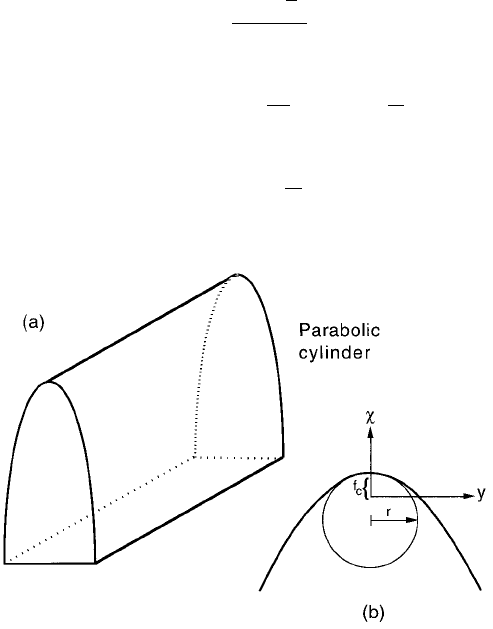
6.6.1 Theory for the Lengthening of Plates
Particle dimensions during diffusion-controlled growth vary parabolically
with time when the extent of the diffusion ®eld increases with particle size.
The growth rate thus decreases because the solute has to diffuse over ever
increasing distances to reach the far-®eld concentration. Plates or needles can
however grow at a constant rate because solute can be partitioned to their
sides.
The partitioning of interstitial elements during displacive transformation
should lead to diffusion-controlled growth because the glissile interface
necessary for such transformation has the highest mobility. Iron and any sub-
stitutional solute atoms do not diffuse so their role is purely thermodynamic.
Trivedi (1970) has solved for the diffusion-controlled growth of plates whose
shape approximates that of a parabolic cylinder (Fig. 6.12). The plate lengthen-
ing rate V
l
at a temperature T for steady state growth is obtained by solving:
f
1
x
r
x
x
r
x
f
1
p
0:5
expfpgerfcfp
0:5
g
1
V
l
V
c
f
1
S
1
fpg
r
c
r
f
1
S
2
fpg
6:20
where the Pe
Â
clet number is
p V
l
r=2D 6:21
Kinetics
143
Fig. 6.12 (a) An illustration of the shape of a parabolic cylinder. (b) De®nitions of
the tip radius r, the focal distance f
c
and the coordinates.
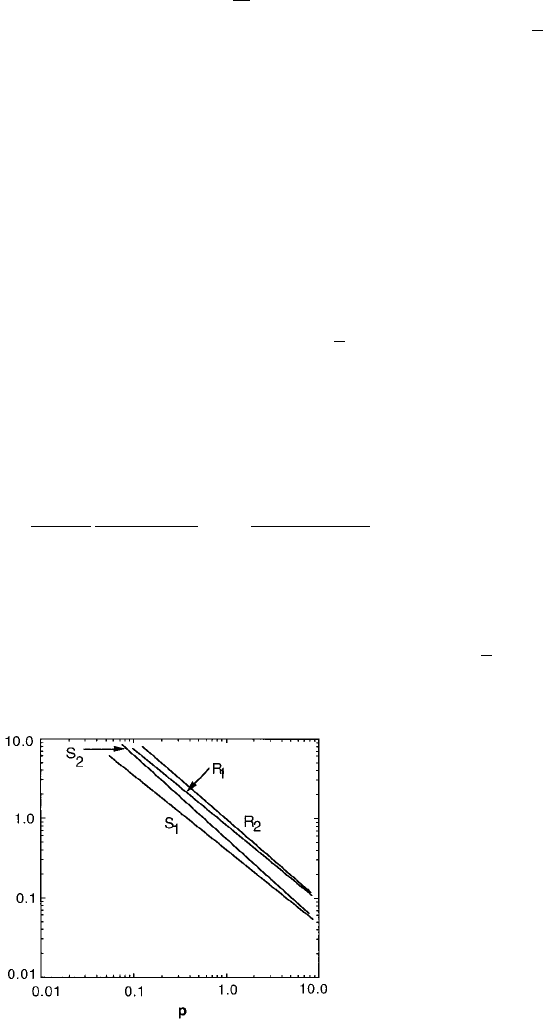
The weighted-average diffusion coef®cient D for carbon in austenite is given
by integrating D (the diffusivity at a speci®c concentration) over the range
x to
x
r
, and then dividing the integral by this range.
The function S
2
fpg of equation 6.21 depends on the Pe
Â
clet number (Fig. 6.13);
it corrects for variation in composition due to changing curvature along the
interface and has been evaluated numerically by Trivedi. The term containing
S
1
is prominent when growth is not diffusion-controlled; V
c
is the interface-
controlled growth velocity of a ¯at interface. For diffusion-controlled growth,
which is discussed ®rst, V
c
is very large when compared with V
l
and the term
containing it can be neglected.
x
r
is the carbon concentration in the austenite at the plate tip. It may differ
from the equilibrium carbon concentration x
because of the Gibbs±Thompson
capillarity effect (Christian, 1975); x
r
decreases as interface curvature increases,
and growth ceases at a critical radius r
c
when x
r
x. For a ®nite plate tip
radius,
x
r
x
1 =r 6:22
where is the capillarity constant given by (Christian, 1975):
V
m
RT
1 x
x
x
1
dln f
C
fx
g
dln x
1
6:23
where
is the interfacial energy per unit area, f
C
is the activity coef®cient of
carbon in austenite, and V
m
is the molar volume of ferrite. This assumes that
the ferrite composition is unaffected by capillarity, since x
is always very
small. The critical plate tip radius r
c
can be obtained by setting x
r
x.
Bainite in Steels
144
Fig. 6.13 Dependence of Trivedi's functions S
1
, S
2
, R
1
and R
2
on the Peclet
number p.
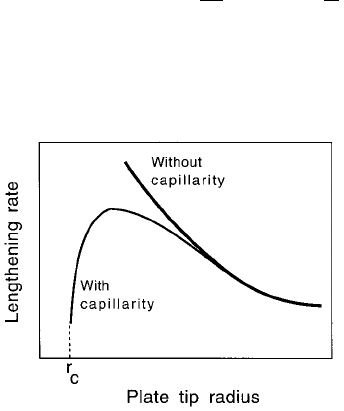
Trivedi's solution for diffusion-controlled growth assumes a constant shape,
but the solution is not strictly shape-preserving. The concentration x
r
varies
over the surface of the parabolic cylinder which should lead to a deviation
from the parabolic shape. Trivedi claims that the variation in x
r
has a negligible
effect provided the tip radius is greater than 3r
c
.
Plate growth theory provides a relation between velocity and tip radius (Fig.
6.14). Additional theory is required to enable the choice of a particular tip
radius and hence to ®x V
l
. Small tip radii favour fast growth due to the
point effect of diffusion, but this is counteracted by the capillarity effect.
Zener proposed that the plate should tend to adopt a tip radius which allows
V
l
to be maximised but this remains a hypothesis. Work on the dendritic
growth of solid from liquid (formally an almost identical problem) has
shown that the dendrites do not select the radius corresponding to the max-
imum velocity. The radius is determined instead by a shape stability criterion
(Glicksman et al:, 1976; Langer and Muller-Krumbhaar, 1978). If these results
can be extrapolated to displacive transformations, and it is doubtful that they
can given that the shape is constrained by strain energy minimisation, then
calculated velocities would be greatly reduced. This does not ®t experimental
data where the lengthening rate is slightly higher that the maximum velocity
predicted theoretically (Bhadeshia, 1985a).
The shape of ferrite plates is sometimes more needle-like (lath) than plate-
like. Trivedi has obtained a steady-state solution for the diffusion-controlled
growth of paraboloids of revolution (i.e. needles):
f
1
p expfpgEifpg
1
V
l
V
c
f
1
R
1
fpg
r
c
r
f
1
R
2
fpg
6:24
The tip radius r
c
is twice as large as that for plates because there are two radii
of curvature for a needle tip.
Kinetics
145
Fig. 6.14 Variation in lengthening rate as a function of the plate tip radius.

6.6.2 Growth Rate of Sheaves of Bainite
After nucleating at austenite grain surfaces, sheaves of bainite propagate by the
repeated formation of sub-units, each of which grows to a limited size. New
sub-units are favoured near the tips of existing platelets; nucleation in adjacent
positions occurs at a much lower rate. Therefore, the overall shape of the sheaf
is also that of a plate in three dimensions with growth limited only by austenite
grain or twin boundaries.
Most direct observations have used optical microscopy and hence monitor
the growth of sheaves rather than of the transformation unit which is only about
0.2 mm in thickness. Suppose that a sub-unit reaches its limiting size in a time
period t
C
, and that a time interval t elapses before the next one is stimulated,
then the lengthening rate, V
S
, of a sheaf is given by:
V
S
V
l
t
C
t
C
t
6:25
where V
l
is the average lengthening rate of a sub-unit.
Bainite sheaves lengthen at a constant rate although the data show con-
siderable scatter, attributed to stereological effects (Speich and Cohen, 1960;
Goodenow et al:, 1963; Hawkins and Barford, 1972). Greater concentrations of
carbon, nickel or chromium concentration reduce V
S
. The growth of sheaves
seems to occur at a constant aspect ratio although thickening continues when
lengthening has stopped. This is not surprising since the sheaf can continue to
grow by the sub-unit mechanism until the T
0
0
condition is achieved.
An assessment of sheaf data shows that the lengthening rate is greater than
expected from diffusion-controlled growth, Fig. 6.15. This includes measure-
ments on Fe±Ni±C alloys which are frequently (incorrectly) used to justify the
existence of some sort of a solute drag effect.
6.6.3 Growth Rate of Sub-Units of Bainite
The growth rate of martensite can be so fast as to be limited only by the speed
of sound in the metal. Although bainite grows rapidly, the lengthening rate is
much smaller than that for martensite. The interface moves relatively slowly
even though it is glissile. This is probably because of the plastic work that is
done as the bainite grows. A good analogy is to compare brittle failure in a
glass where cracks propagate rapidly, with cleavage failure in metals which is
not as rapid because of the plastic zone which has to move with the crack tip.
The lengthening rate of sub-units has been measured using hot-stage photo-
emission electron microscopy. Electrons are excited from the surface of the
sample using incident ultraviolet radiation, and it is these photo-emitted elec-
trons which form the image. The technique can resolve individual sub-units of
Bainite in Steels
146
